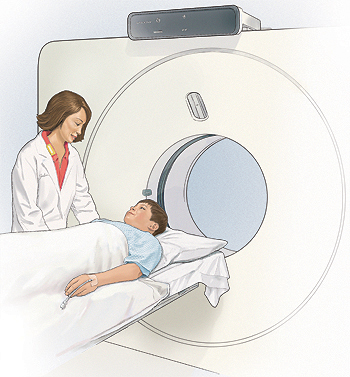Overview of Diagnostic Tests for Nervous System Disorders in Children
What are some diagnostic tests for nervous system disorders?
Evaluating and diagnosing nervous system problems can be complex. Many of the same symptoms occur in different ways among the different disorders. And, many disorders don't have clear causes, markers, or tests.

Neurological tests to evaluate children may include:
CT scan (also called a CAT scan). This imaging test uses X-rays and computer technology to make horizontal, or axial, images (often called slices) of the body. A CT scan shows detailed images of any part of the body, including the brain, bones, muscles, fat, and organs. CT scans are more detailed than general X-rays. This test can be done quickly and most children can undergo a CT scan without sedation.
Electroencephalogram (EEG). This test records the brain's continuous, electrical activity through electrodes attached to the scalp.
MRI. This test uses a combination of large magnets, radiofrequencies, and a computer to make detailed images of organs and structures within the body. This study can't be done if your child has any metal in their body. This includes braces, or certain dental appliances. Sometimes it is necessary to remove braces or dental devices in preparation for an MRI. Talk to your child's healthcare provider to determine if this is necessary. MRI studies take longer than CT, and the machine makes a lot of noise. Young children may require sedation to remain still throughout the MRI exam.
Electrodiagnostic tests. These include electromyography and nerve conduction velocity. These studies evaluate and diagnose disorders of the nerves, muscles and motor neurons. Electrodes are inserted into the muscle, or placed on the skin overlying a nerve, muscle, or muscle group, and electrical activity and muscle response are recorded.
Positron emission tomography (PET) scan. This computer-based imaging test provides a picture of the brain's activity rather than its structure by measuring levels of an injected substance with a tracer molecule, most often glucose.
Arteriogram (also called angiogram). This test provides an image of arteries and veins going to and through the brain. CT angiography, a newer and less invasive technique, is sometimes used.
Cerebral spinal fluid analysis (also called spinal tap or lumbar puncture). This test takes a sample of cerebrospinal fluid from the spinal cord for examination.
Evoked potentials. This test records the brain's electrical response to visual, auditory, and sensory stimuli.
Myelogram. A test that uses dye injected into the spinal canal to make the structure clearly visible on X-rays. Though once common, this is rarely used.
Ultrasound (also called sonography). This test uses high-frequency sound waves and a computer to create images of blood vessels, tissues, and organs. Ultrasounds are used to view internal organs as they function, and to assess blood flow through various vessels. Ultrasound of the brain can only be done in the first few months of life while the infant's fontanels, or soft spots, are open.
Neurosonography. This test uses ultra high-frequency sound waves to evaluate structures of the nervous system, including the brain, spinal cord, and other structures.
How should I prepare my child for neurological testing?
Infants
You can't explain the test to an infant, but you can help your baby feel more secure during the test by bringing a special blanket, toy, or pacifier. For many of the studies, sedation or anesthesia is used, which requires the child to fast before the procedure. You may breastfeed your baby or give him or her a bottle of juice or formula once the technician tells you your baby can eat.
Toddlers and preschool-aged children
Young children remember things for only a short time, so the best time to talk about the test is right before you are ready to come to the hospital. Explain to your child that you are going to the hospital to have some pictures taken that the doctor needs to help him or her get better. Try to use simple words. For tests that require the child to be still, such as a CT, MRI, or lumbar puncture, sedation or anesthesia may be used to ensure a good quality image and prevent pain.
It is important to be honest with your child. If the test will be uncomfortable, be sure to talk about and tell him or her it is OK to cry. Because children at this age are afraid of being separated from their parent, let him or her know that mom or dad will stay with him or her as much as possible. When you come to the hospital, bring a favorite book, toy, or blanket.
School-aged children
School-aged children have good imaginations. If you do not tell them the truth, they may imagine something much worse than the actual test. The day of the test, tell your child that he or she will be going to the hospital to have some pictures taken. Tell him or her that the pictures will help the doctor decide how to make him or her better. Use simple words. Be honest. Try to tell your child exactly what will happen. If your child's test is going to be uncomfortable, be sure to tell him or her it is OK to cry. When you come to the hospital, bring along a favorite book, toy, or game. Depending on the age and emotional maturity of the child, sedation, or anesthesia may be used.
Connect with us:
Download our App: